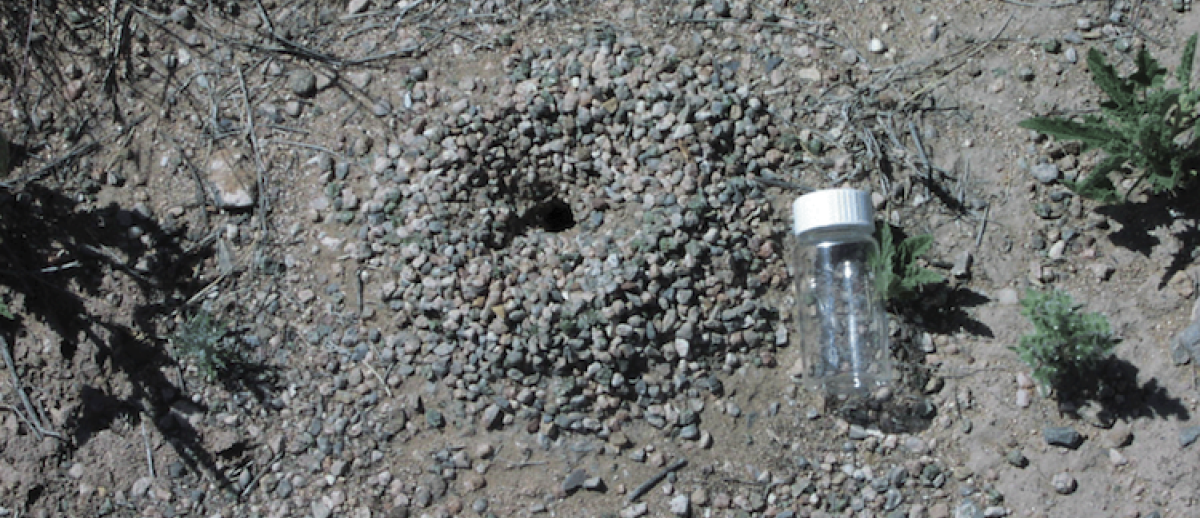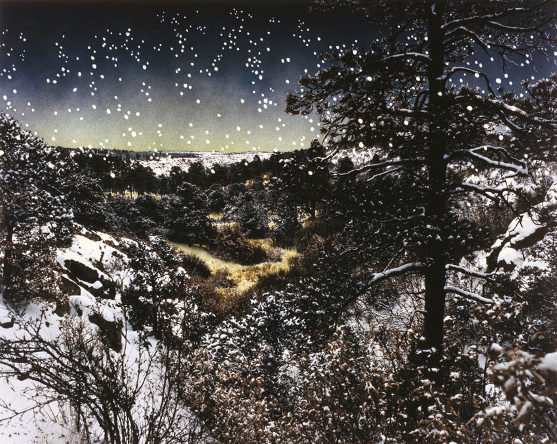Sensing Radioactive Deserts: Mediating Florae and Rocks in New Mexico’s Anthropocene
archive


Trinitite fragments around the top of an anthill near the Trinity site in New Mexico. (Source: "Trinitite—the atomic rock.")
Sensing Radioactive Deserts: Mediating Florae and Rocks in New Mexico’s Anthropocene
The US just announced its support for Japan’s plan to release contaminated water from the Fukushima nuclear plant into the ocean. This plan will move forward despite the risks to countless marine ecosystems.1 The continued backing of many governments around the globe for these sorts of reckless actions reminds us why scholars in the botanical humanities, such as philosopher Michael Marder, have turned towards the nonhuman—and to the plant, specifically, as sensor—in relation to nuclearity to provide us with new perspectives. Marder develops the concept of an “exploded consciousness”— a multivalent term that describes how certain segments of humanity allowed their values to twist and transform so that the use of nuclear technology became commonplace, and how those same groups must now widen their consciousness for more sustainable futures to be possible. Marder deploys this concept to reflect on the horrors of Chernobyl alongside of photograms of plants near the site, and he explores how the vegetal might promote a complete rethinking and re-sensing of nuclearity.2 He draws upon these artistic representations of plants as alternative witnesses, providing alternative sensibilities to the nuclear terrors at Chernobyl.
In this essay, I follow Marder’s example to briefly think through key representations of plants and radioactive rocks associated with the nuclear industry in New Mexico. The state called “the land of enchantment” was the birthplace of the atomic bomb and where the world’s first atomic attack3 was planned and executed. Such realities are unsurprising given the common racist imaginaries that have long circulated about the region due to the strength and large populations of Indigenous and Xicanx/a/o communities4 and the region’s shift from a formal colony for nearly 70 years into a nuclear colony.5 Today, New Mexico continues to be the only state in the US that supports every part of the nuclear economy.6 In both Los Alamos and the Trinity Site—two desert (or approximate desert) sites with profound connections to the natal moments of the nuclear age—a variety of florae and melted arkosic sand (trinitite) have functioned as technical and cultural sensors for radioactivity. I first outline how both parts of this uncommon assemblage have functioned in service of a form of nuclear technoculture in the region. I then turn to the representation of these same rocks and plants in the images in the “Nuclear Enchantment” series created by Japanese American photographer Patrick Nagatani and briefly consider how his art might gesture towards the framework of an exploded consciousness and decolonial potentialities in the New Mexican context. These potentialities are crucial for local communities, such as those impacted downwind of Trinity and other atomic explosions in the Southwest.
Nuclear Worlding and the Vegetal at Los Alamos
In 1997, a report was published by Los Alamos National Laboratory, the facility where the first atomic bomb was assembled, on the quantities of radionuclides found in crops grown around the Lab. The report went to great lengths to clarify that the Lab had made prodigious efforts—although those efforts were absent in the report—to contain the release of radionuclides into the local environment near Los Alamos.7 Using pinto beans (Phaseolus vulgaris), sweet corn (Zea mays), and zucchini squash (Cucurbita pepo),8 scientists were able to evaluate the levels at which these plants would consume radionucleotides. These plants were selected for this nuclear garden since they composed some of the fundamental foods “commonly cultivated” by local Indigenous groups. Such cultivation matters, since the consumption of crops is a major pathway that facilitates the transfer of radionuclides into human bodies.
Unsurprisingly, the radionucleotide levels found near the facilities were dangerous for human consumption based on EPA standards. In this way, this nuclear garden became a garden of sensors for radiation. However, such sensing is not just for “scientific objectivity” but, more broadly, it supports particular cosmological and worlding visions. According to anthropologist Joseph Masco, “we need to approach the nuclear complex as a material cosmological statement, in whose nature we can read a constellation of issues concerning technoscience, militarism, and security…” (my emphasis).10 Thus, these plants provide “raw data” to then be cycled financially, epistemologically, structurally, and visually into nuclear imaginaries. Nuclear imaginaries have always been about design and disaster and they have led to design as disaster, to partially borrow from the very relevant work of Arturo Escobar on design and development.11
[S]uch sensing is not just for “scientific objectivity” but, more broadly, it supports particular cosmological and worlding visions.
Trinitite as a Cultural Sensor
Trinitite is formed from arkosic sand, abundant in feldspar (including both microcline and small amounts of plagioclase) together with calcite, hornblende, and augite in a matrix of sandy clay. Instead of lab tests and radiation levels, trinitite is mediated at and near the Trinity Site in quite different ways that are more about mediating a particular cultural and knowledge milieu. For instance, while driving to Trinity, one notices several “trinitite vendors” that proudly advertise the sale of the rock formed from the heat of the Trinity blast. Such advertisements function in the larger capitalistic and propagandic efforts to transform the world’s first nuclear attack into a commercialized event worthy of souvenirs. Upon arrival at the site, trinitite becomes an item that is both omnipresent and always out of reach; visitors are warned by both signs and soldiers that they cannot take the rocks despite their being surrounded by them. Indeed, pieces of trinitite constantly surface, carried up by ants. Yet visitors are also told that the trinitite and the site itself are largely safe and that radiation levels are just slightly greater (only 10 times greater) than the region’s background radiation. Trinitite becomes a symbol of the sanitation of nuclear cosmology—a technology and a weapon that is eccentric, unique, but was only briefly and is now certainly no longer dangerous. The rock serves as a semiotic sensor in that it attunes visitors both to the unique and radioactive nature of the site but only to serve as a reminder of its now passive nature.
Art and Exploded Consciousnesses in the Deserts of the Southwest
In the examples above, we see how plants and minerals are accepted as viable and, indeed, enchanting technologies and technocultural items of nuclear worlding. Alternatively, local cosmologies and worlding efforts by local Indigenous and Xicanx community leaders and activists have consistently been neglected when it comes to nuclear infrastructures and their impacts. The pleas of local Indigenous communities and activist allies such as Concerned Citizens for Nuclear Safety went ignored for years near Los Alamos. Tragically, oral histories of the disasters that began at the commencement of the nuclear era continue to be ignored as well. The government’s current dismissal of and inaction towards the claims made by the Tularosa Basin Downwinders12—a group composed largely of those in Indigenous and Xicanx communities in southern New Mexico impacted by Trinity and subsequent nuclear explosions in the Southwest—mirrors the “slow violence” that these communities have faced.13

“Trinitite, Ground Zero” by Patrick Nagatani (Source: https://www.patricknagatani.com/).

“Contaminated Radioactive Sediment, Mortandad Canyon, Los Alamos National Laboratory, New Mexico”by Patrick Nagatani (Source: https://www.patricknagatani.com/).
But what kinds of visual projects move us towards a reconstitution of consciousness in a world in which international governments have become all too dulled to questions of radioactivity—a world in which the US, as Tina Cordova points out in her recent piece in this journal, has neglected to act to address those victims of the world’s first atomic explosion? I conclude here by highlighting Patrick Nagatani’s “Nuclear Enchantment” photography series which leads us to consider how the first step in reconstituting political action when it comes to the nuclear might be understanding how our senses have been dulled. Nagatani uses what he terms a visual “leveling,” and presents radioactivity in New Mexico as something omnipresent.14 Such artistic decisions both overwhelm the viewer and simultaneously reveal how New Mexico’s nuclearity has been commodified and made banal. “Trinitite, Ground Zero” displaces Trinity as tourist site to a site again filled with risk as symbolized by the very trinitite that has been largely commodified elsewhere. “Contaminated Radioactive Sediment, Mortandad Canyon, Los Alamos National Laboratory, New Mexico” emphasizes how radioactivity was never centralized (despite the prior claims of Los Alamos Labs) and has always been a threat to entire ecosystems. Perhaps, such works in the visual and plastic arts allow us to center the nonhuman actors in the environment and, in turn, those local human communities as well by decentering the cosmovisions of scientists and political officials of containment. The struggles of citizens today in Japan, and of the Tularosa Basin Downwinders in New Mexico, remind us the importance of local voices and the art that seeks to emphasize their dire concerns.
1. The Hill. The danger of Japan dumping Fukushima wastewater into the ocean, 04/17/21. https://thehill.com/opinion/energy-environment/548726-the-danger-of-japan-dumping-fukushima-wastewater-into-the-ocean
2. Michael Marder. The Chernobyl Herbarium: Fragments of an Exploded Consciousness. London: Open Humanities Press, 2016.
3. I prefer the word attack instead of “test” to highlight the inherent violence of any nuclear explosion. I also use this word to highlight that government planners expected destruction, lawsuits, and casualties. For more information see “Unknowing, Unwilling and Uncompensated: The Effects of the Trinity Test on New Mexicans and the Potential Benefits of a Radiation Exposure Compensation Act (RECA) Amendment” by Myrriah Gómez. https://www.kob.com/kobtvimages/repository/cs/files/TBDC%20HIA%20final%20report%202-8-2017.pdf
4. For more on the “double” colonial history of New Mexico and the racialization of its communities within the US context see Manifest Destinies: The Making of the Mexican American Race by Laura E. Gómez.
5. For more on this history see works such as The Nuclear Borderlands: The Manhattan Project in Post-Cold War New Mexico by Joseph Masco, Understories: The Political Life of Forests in Northern New Mexico by Jake Kosek, and The Land of Nuclear Enchantment: A New Mexican History of the Nuclear Weapons Industry by Lucie Genay.
6. Joseph Masco. The Nuclear Borderlands: The Manhattan Project in Post-Cold War New Mexico. Princeton, NJ: Princeton University Press, 2006.
7. P.R. Fresquez, D.R. Armstrong, M.A. Mullen, L. Naranjo Jr. “Radionuclide Concentrations in Pinto Beans, Sweet Corn, and Zucchini Squash Grown in Los Alamos Canyon at Los Alamos National Laboratory”, Los Alamos National Laboratory, p. 2
8. Ibid, pp. 4—5.
9. Ibid.
10. Masco, The Nuclear Borderlands, p. 17
11. Arturo Escobar. Designs for the Pluriverse: Radical Interdependence, Autonomy, and the Making of Worlds. Durham: Duke University Press, p. 7
12. This article was written as part of the collaborative work being carried out between graduate student scholars at the Orfalea Center for Global & International Studies at the University of California, Santa Barbara and the Tularosa Basin Downwinders.
13. Nixon, Rob. Slow Violence and Environmentalism of the Poor. Cambridge, MA: Harvard University Press, 2011.
14. Patrick Nagatani. Artist statement for “Nuclear Enchantment”. https://www.patricknagatani.com/.



